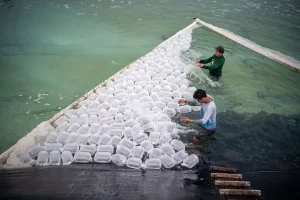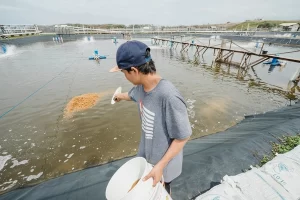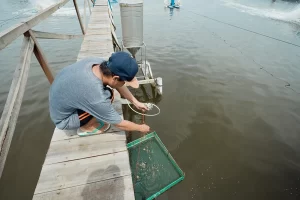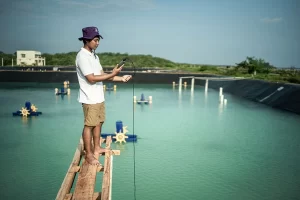Many people want to start vannamei shrimp cultivation but still need to figure out where to start. It is because shrimp cultivation can not be arbitrary. There are many preparations and things that you must consider before starting it.
Vannamei shrimp is a fishery commodity that has high economic value. Since it was first introduced to Indonesia, vannamei shrimp has become a prima donna among farmers.
This is because the shrimp, which has the Latin name Litopenaeus Vannamei, has excellent resistance to the environment and can adapt quickly. Not only that, market demand for vannamei shrimp also continues to increase.
Unsurprisingly, many people are interested in starting vannamei shrimp cultivation. Well, for those who want to begin vannamei shrimp farming. Check out the following ways in this article!
Also Read: Introducing Aquaculture to the Community, DELOS Joined Seminar and Musda SCI Jabar-Banten
Cultivation Preparation Stage
1. Pond Preparation
In vannamei shrimp cultivation, the first thing you must do is the Preparation of the pond to form an ecosystem conducive to the maintenance of shrimp during one cultivation cycle.
During pond preparation, there are several things you must ensure:
- The pond is clean, dry, and not leaking.
- Adjustment of aeration and turbulence needs with production targets, configurations, energy availability, and cultivation systems.
- Ensuring ponds are free from potential remnants of microorganisms that can harm aquaculture activities, such as bacteria, viruses, etc.
2. Preparation of Farm and Laboratory Equipment
Each pond must have its equipment and may be used differently from other ponds. Both tools in the field, such as siphon hoses, Secchi disks, scoops, wall mounts, buckets, and water samplers, and laboratory equipment, such as water quality checkers, pH meters, and DO meters.
Therefore, the farmers must properly prepare every tool needed. Ensure all the equipment is complete and ready to use before the cultivation cycle begins.
3. Preparation of Human Resources
Not only pond preparation and equipment, competent and adequate human resources must also be prepared for vannamei shrimp cultivation. This is so that the cultivation of vannamei shrimp can run effectively and efficiently.
Make sure the number of human resources, expertise, and division of tasks for each person is carried out clearly. Good human resource preparation will result in neat pond data recording and more successful vannamei cultivation.
4. Pond Sterilization
Pond sterilization is included in the water preparation stage, which forms the essential ecosystem where the shrimp will grow and develop. Farmers must ensure that the combination of autotrophic and heterotrophic bacteria in the pond is balanced through this stage.
In addition, make sure no pathogens and other pests remain in the pond. Usually, sterilization is carried out by adding chlorine according to the rules and dosages that apply.
5. Microorganism Spreading
The final Preparation before cultivating vannamei shrimp is the spreading of microorganisms. These microorganisms can later become natural food for shrimp. But not only that, but microorganisms can also help absorb ammonia, produce oxygen, stabilize water temperature, and fight harmful bacteria.
Also Read: Get to Know the Vannamei Shrimp as a Farmers’ Favorite
Vannamei Shrimp Cultivation Procedures
1. Selection and Stocking of Seeds

The selection of fry is the key to success in vannamei cultivation. The ideal fry should be disease-free and disease resistant. In addition, several other criteria must be met, including body length > 10 mm, size variation < 1, intense color pigment, and active swimming spread.
Before the fry is stocked, acclimatization must first be carried out to accelerate the adaptation of the fry from the bag water medium to the pond water ecosystem. This stage also avoids stress on the fry and reduces the mortality rate when stocking.
2. Feeding Management

Intensive vannamei shrimp cultivation cannot be done without artificial feed. Therefore, farmers must prepare good feed management to maximize the cultivation that is carried out.
Shrimp feed management is a step to maximize the benefits of feed to support successful cultivation. Feed management is one of the most critical factors, especially about the capital spent. The more effective and efficient a person manages vannamei shrimp feed, the more efficient the money spent will be.
3. Do Routine Sampling

Routine sampling aims to determine the condition and development of shrimp during cultivation. Sampling is an important activity to see the growth of laws needed for evaluation, one of which is feeding.
Usually, sampling is carried out within a certain period to determine average body weight (ABW), growth (ADG), population estimation, survival rate (SR), biomass, and to observe the quality of the shrimp.
4. Water Quality Management

As long as vannamei shrimp cultivation takes place, farmers must implement good water quality management and continue to observe it. This is so that if there is a change or fluctuation in water quality parameters during cultivation, it will be easier for farmers to find out.
The water used for vannamei cultivation is seawater with a salinity level above 15 ppt which must be replaced every 60 days. While the parameters used to measure water quality include pH, DO, temperature, brightness, total ammonia nitrogen, NH3, total vibrio count, alkalinity, salinity, and the type and amount of plankton.
5. Vannamei Shrimp Treatment

Farmers must ensure that the shrimp are healthy and receive optimal nutritional intake during cultivation. Therefore various treatments, such as giving probiotics and vitamins, are necessary.
In addition, ponds must also be disinfected according to standards to inhibit the growth of microorganisms that are bad for the sustainability of cultivation.
6. Harvest

The last is the harvest stage, the process of picking the results from your vannamei cultivation. The harvest stage is divided into four: the overall harvest (total harvest), partial harvest (partial harvest), abnormal harvest, and emergency harvest.
A typical harvest occurs if the vannamei shrimp AW reaches more than 14 grams. Partial harvest is usually done when the pond capacity has reached the maximum limit. At the same time, abnormal and emergency harvests are carried out when certain things occur during cultivation, such as a high mortality rate.
Also Read: Tiger Shrimp vs Vannamei Shrimp, Which One is Better for Cultivation?
Capital for Vannamei Shrimp Farming
Vannamei shrimp business is indeed promising, with fantastic profit potential, which has made it increasingly popular among the community. However, on the other hand, the capital required to start vannamei shrimp farming is not insignificant.
The amount of capital for vannamei shrimp farming depends on several factors. For example, the type of technology applied, whether it’s traditional, semi-intensive, intensive, or super-intensive.
The capital for vannamei shrimp farming can be divided into two categories: fixed capital and working capital.
Fixed capital refers to the initial capital invested when starting vannamei shrimp farming. The amount remains constant and is not affected by the fluctuation of operational costs. It includes expenses such as purchasing land (if you don’t already own it), equipment costs, and pond construction.
Working capital for vannamei shrimp farming is the ongoing expenses incurred during the farming process. These costs are fluctuating and depend on the operational needs of the farm. For example, costs for seedlings, fertilizers, feed, supplements, probiotics, and so on.
The amount of working capital can vary depending on your choice of high-quality fertilizers, feed, supplements, and probiotics. This will ultimately result in good harvest quality.
Choose DELOS Farm Management for Your Shrimp Cultivation
Starting vannamei shrimp cultivation can be a hassle for beginners. Many preparations must be made so that the cultivation gets optimal results.
However, you don’t need to worry because DELOS is ready to help you manage your shrimp pond. DELOS is the best science, technology and operational management-based aqua-tech company that can help you explore new opportunities in the aquaculture field.
DELOS Farm Management is also integrated with the AquaHero application, making it easy for farm owners and farm technicians to monitor their shrimp ponds daily.
Need help with supply issues for pond needs? DELOS also has a Supply Chain Integration program named AquaLink. We can help connect you with producers and farm owners to get and sell pond products at the best prices.
You can quickly contact the DELOS Team via contact@delosaqua.com or submit via our website contact column www.delosaqua.com, to find out more about our Farm Management and Supply Chain Integration programs. Trust your farm management to DELOS!


